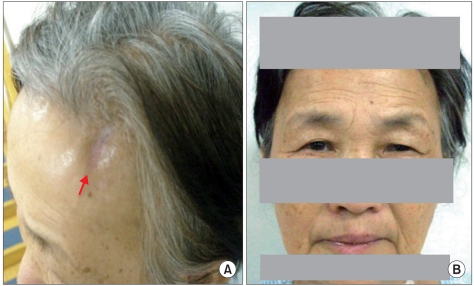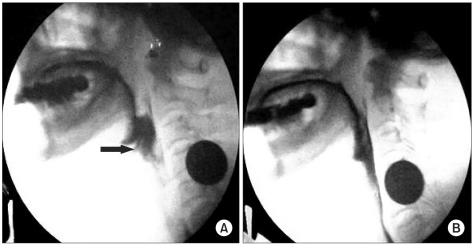Ann Rehabil Med.
2012 Feb;36(1):167-170. 10.5535/arm.2012.36.1.167.
A Case of Cephalic Tetanus with Unilateral Ptosis and Facial Palsy
- Affiliations
-
- 1Department of Rehabilitation Medicine, College of Medicine, Dankook University, Cheonan 330-715, Korea. magnarbor@dkuh.co.kr
- KMID: 2266798
- DOI: http://doi.org/10.5535/arm.2012.36.1.167
Abstract
- Cephalic tetanus is defined as a combination of trismus and paralysis of one or more cranial nerves. Cranial nerves III, IV, VI, VII, and XII may be affected, but the facial nerve is most frequently implicated. A 64-year-old female visited hospital for left ptosis followed by facial palsy after a left forehead abrasion in a car accident. At nine days post injury, left ptosis developed, left facial palsy developed twelve days post injury, and at fifteen days post injury, trismus and dysphagia developed. The following day, there was progression of symptoms to generalized tetanus, such as dyspnea and generalized rigidity. Videofluoroscopic swallow study showed penetration and aspiration. We report a case of cephalic tetanus with ptosis, facial palsy, and dysphagia, which progressed to generalized tetanus.
Keyword
MeSH Terms
Figure
Reference
-
1. Jagoda A, Riggio S, Burguieres T. Cephalic tetanus: a case report and review of the literature. Am J Emerg Med. 1988; 6:128–130. PMID: 3281682.
Article2. Ryu SH, Seo IY, Park HJ, Oh HK. Cephalic tetanus: a case report. J Korean Assoc Oral Maxillofac Surg. 2004; 30:345–348.3. Bleck TP. Tetanus: pathophysiology, management, and prophylaxis. Dis Mon. 1991; 37:545–603. PMID: 1874121.
Article4. Burgess JA, Wambaugh GW, Koczarski MJ. Report of case: reviewing cephalic tetanus. J Am Dent Assoc. 1992; 123:67–70. PMID: 1619169.5. Park DM. Cranial nerve palsies in tetanus: cephalic tetanus. J Neurol Neurosurg Psychiat. 1970; 33:212–215. PMID: 5443484.
Article6. Mayo J, Berciano J. Cephalic tetanus presenting with Bell's palsy. J Neurol Neurosurg Psychiatry. 1985; 48:290. PMID: 3981208.
Article7. Gleeson T, Erienne M. Cranial nerve VII palsy as the first sign of cephalic tetanus after an earthquake. Arch Neurol. 2011; 68:536–537. PMID: 21482936.
Article8. Liu CY, Liao KK, Fuh JL, Wang PN, Shan DE, Tsai CP. Unilateral blepharospasm as an early sign of cephalic tetanus. Mov Disord. 2009; 24:1094–1095. PMID: 19243061.
Article9. Smith AT, Drew SJ. Tetanus: A case report and review. J Oral Maxillofac Surg. 1995; 53:77–80. PMID: 7799128.



